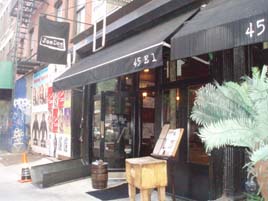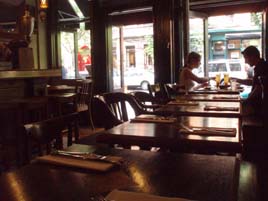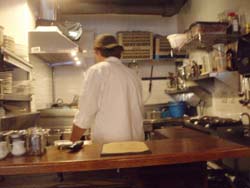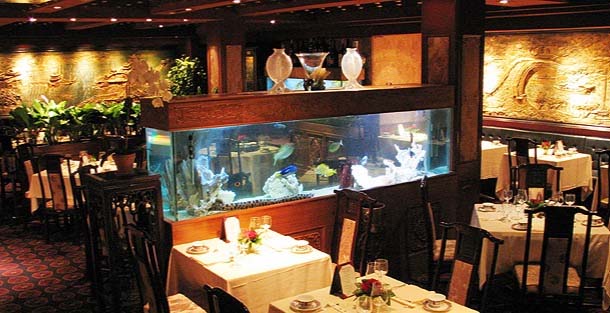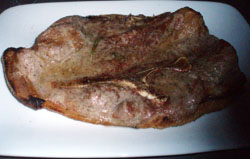 Chef Daniel Boulud is gradually working his way down the formality ladder. His five New York restaurants, in order of opening, are Daniel, Café Boulud, DB Bistro Moderne, Bar Boulud, and now DBGB—each more casual than its predecessor.
Chef Daniel Boulud is gradually working his way down the formality ladder. His five New York restaurants, in order of opening, are Daniel, Café Boulud, DB Bistro Moderne, Bar Boulud, and now DBGB—each more casual than its predecessor.
This is sensible positioning on Boulud’s part. Each of his five NYC properties fills a distinct niche, but all of them retain an essential French soul. In that respect, he parts company with fellow four-star chef Jean-Georges Vongerichten, who puts his name to a much wider variety of concepts, many of which have little to do with the cuisine he is famous for.
Not that DBGB is a classical French restaurant—it serves hamburgers and hot dogs, after all—but the core of the menu is French, and it’s a sensibly edited document. It doesn’t try to be all things to all people—as David Bouley tried and failed last year at Secession.
And Boulud knows how to roll out a restaurant. Industry glitterati were all a-twitter at the opening, fawning over the chef’s beer and sausages, admiring the row of cooking pots dotted along the walls, all donated by famous chefs. Beneath its rustic pretensions is a business model that, according to the Times, needs to gross $4.5 million per year to be profitable.
None of this is resentment. Actually, it’s admiration. Boulud could teach the rest of the industry how to open a restaurant. Even at his most casual place, the kitchen runs smoothly. The serving staff are attentive and friendly. They take reservations, check parcels, and transfer the bar tab to the table. It’s nice to know that at least some of David Chang’s antics aren’t being copied by everyone.
 The menu is a slave to fashion in at least some respects, with many sections that blur the traditional lines between appetizers and entrées, a system that encourages sharing, and at times over-ordering. We had about the right quantity of food, but it was far too monotonous, and our stomachs felt weighed down at the end of the evening. We may well have chosen the wrong mix of items, and in that respect neither the menu nor our server offered much guidance.
The menu is a slave to fashion in at least some respects, with many sections that blur the traditional lines between appetizers and entrées, a system that encourages sharing, and at times over-ordering. We had about the right quantity of food, but it was far too monotonous, and our stomachs felt weighed down at the end of the evening. We may well have chosen the wrong mix of items, and in that respect neither the menu nor our server offered much guidance.
About that menu: there are cold appetizers ($7–17), fruits de mer ($30, 60, 90), hot appetizers ($8–16), charcuterie (a subset of the Bar Boulud menu; $7–12); sausages ($9–15); a section labeled tête aux pieds, which I interpret loosely as “head and feet” ($9–12), entrées ($16–26), three different burgers ($14–19), and side dishes ($6).
Despite all of those categories, the menu manages to avoid the appearance of rambling. The largest section is the sausages, with 14 choices. Along with the tête aux pieds, it’s somewhat confusingly captioned “To Share,” although the section also includes the DBGB Dog ($9), which is just a standard hot dog, albeit with house-made sautéed onions and relish.
We ordered one hot appetizer, two sausages, and one of the tête aux pieds, all to share. This may have been the wrong way to appreciate the menu, but our server either encouraged, or at least did not discourage us from doing this. The kitchen sent out the items one at a time, and at a good pace.


We loved the Octopus à la Plancha ($12; above left), an ample portion lightly cooked, exactly as it should be. Our next item was supposed to be the Toscane ($11; above right). We are not sure if we got the right thing, as it was in a sub-section of the menu captioned “spicy,” and we found nothnig spicy or Tuscan about it. This was the one part of the evening when we could not flag down a server, so we decided to just eat what we had been given. The sausages here tasted like dressed-up breakfast—which is to say, not bad but not wonderful either.


Our next item, the Tunisienne ($15; above left) lived up to its billing. A spicy lamb & mint merguez gave way to a punchy braised spinach with chickpeas. Other sausages caught my eye, such as the Toulouse (pork & duck gizzard with cassoulet beans) and the Boudin Basque (spicy blood and pig’s head), but those will have to wait until another day.
The Pied de Cochon, or pig’s foot ($13; above right) needs to come with a Surgeon General’s warning. It’s hard to tell from the photo, but this thing is huge. Even to share, it was probably excessive. Meat from the pig’s foot appeared to have been smoked, braised, then wrapped in a log and deep fried. There were a few small pieces of bone that apparently remained by mistake, though it is hard to say for sure, as I have nothing to compare it to. The dish was intense, but in the end a bit cloying.
A side order of fries (photo above; $6) was a tad on the mushy side.
There’s a wine list, naturally, but we ordered from the long list of beers, which pair well with such fat-laden food.
DBGB is a noisy restaurant. There are a few booths in alcoves that seem to offer a bit of seclusion, but they’re available only for larger parties. Most diners, even VIPs, are seated in the larger central section, where the packed tables and exposed hard surfaces are tough on the ears. Despite the raucous atmosphere, servers are dressed smartly, and we saw at least three managers prowling the floor and checking on customers’ wants. Except for one brief stretch when we could get no one’s attention to ask about our Tuscan sausage, it seemed there was always a server, a runner, or a manager stopping by—even if you couldn’t quite hear them.
There is much more here, and if the restaurant were on my way home I’d visit a lot more frequently, but I feel full just thinking about all of that fattening food. I’d still like to come back for the “Piggie” (a 6 oz. burger topped with Daisy May’s pulled pork), but I think I need to diet first.
DBGB (299 Bowery at E. 1st Street, East Village)
Food: *
Service: *½
Ambiance: *
Overall: *

 Monday, September 14, 2009 at 04:49PM
Monday, September 14, 2009 at 04:49PM 


















